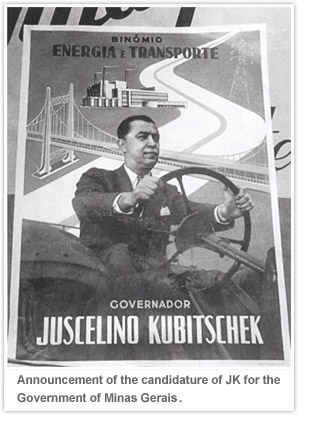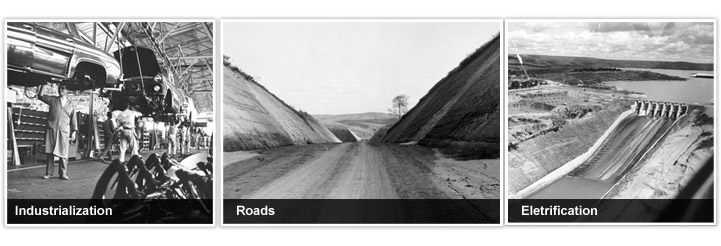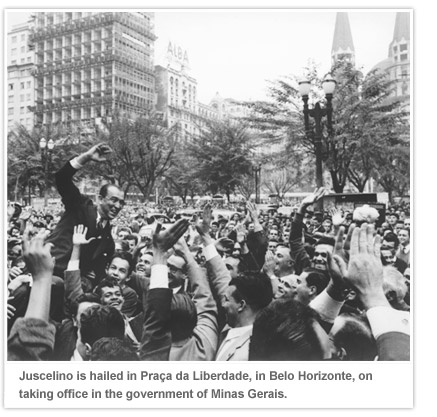Notícias
1950
 Governor-Elect.
Governor-Elect.
The 23 party members of PSD had to choose by vote who would be the party’s candidate for state governor of Minas Gerais in the coming elections: JK or Bias Fortes. JK won by a margin of three votes, and his candidacy was officially endorsed on July 30. His campaign was launched immediately. The campaign slogan “Energy and Transportation” would become a major theme of his platform, along with references to his achievements as mayor of Belo Horizonte. JK was elected governor of Minas Gerais on October 5, 1950. JK took office as governor of Minas Gerais on January 31, 1951.
The governorship was a rewarding and highly important experience for him, especially as the position demanded all his attention, capacity, and energy. JK wanted to meet the highest expectations of his voters during his administration. His proposals were audacious, and provoked a series of disputes with his opponents. However, he knew that the best way to prove his proposals right was through his work, and work he did. JK knew the condition of the state perfectly well. After all, he had been gathering precise information about the most important issues of his coming term before taking office.
Time seemed to have stood still in Minas Gerais. Despite showing spots of development in very few, scattered areas, such as for example in the region of Juiz de Fora, where an advanced industrial nucleus was located, the state did not even dispose of own energy generation nor did it have a network of good roads. JK chose to develop these two sectors as quickly as possible. He intended to advance what he had promised the people of Minas Gerais with the two key terms of his campaign “Energy and Transportation.”
It proved necessary to increase the state’s capacity for energy generation, which at the time attained 205 thousand kW, to at least 600 thousand kW, and to create a new and closer network of roads through the construction of three thousand additional kilometres (approx. 1,700 miles) of roads. To carry out these projects, strong public support was key. In order to demonstrate his devotion and respect for the people, JK worked out plans to increase the salaries of public servants as soon as he assumed his governorship. To do so, JK needed to reduce the public debt he had inherited from previous governments. At the time, the debt burden had reached 1,650,000 contos.
JK was able to gather the people behind his plans. His three concrete plans were:

To increase the energy generation capacity, a series of measures needed to be taken during the four years of his term. His energy team required a centralized agency to bundle the activities. For this purpose, “Centrais Elétricas de Minas Gerais” (CEMIG) the electricity agencies of Minas Gerais) was created. This agency was active not only during his government but also during the following ones.

Under Lucas Lopes chairmanship, CEMIG initiated a series of projects such as the construction of the power plants Usinas de Salto Grande, Itutinga, Piaú, Tronqueiras, Cajuru, Florestal, Fecho do Funil, and Ponte dos Peixotos. In addition, CEMIG installed 912 kilometers (approx. 540 miles) of electric wires for power transmission.
With electrification in place, the state could stimulate industrialization. The creation of a steel manufacturing sector within the state was of special importance for the promotion of industrialization. Minas Gerais succeeded in attracting the plant Metalúrgica de Mannesman, a subsidiary of the German metalworking company, which was to bring JK closer to the realization of his plans. He wanted to pull Minas Gerais out of a “crop and stock farming” state, and to lift the state to conditions more favorable to industrialization. It was necessary to build roads that facilitated transportation to the interior, that instilled social exchange, and that enhanced the trade in the state’s commodities. The economic situation of Minas Gerais improved. 3,087 kilometres (approx. 1,800 miles) of roads were built under the supervision of DER, and 251 bridges were erected all over the state. The construction of roads furthered economic integration in many respects, even agricultural production benefited. In order to create incentives for agricultural production itself, JK founded FRIMISA and FERTISA, two organizations that aimed at modernizing both crop and stock farming.
JK did not only focus on what he had promised during his campaign. Instead of merely pursuing the main goals expressed in his platform’s two key terms, he did much for public health and education too. More than 120 postos de saúde (health service posts) were created. Distributed throughout the interior of the state and intended to better the health of the people, these posts fostered the growth of Minas Gerais in many respects. Healthy citizens are better able to sustain themselves and to contribute to the community.
In the area of education, the enrolment figures at primary schools doubled. When JK took office as governor, only 680,000 pupils went to primary school, while 1,100,000 pupils were enrolled in primary school at the end of JK’s term. Moreover, “137 school buildings were erected, 37 new sports fields built, … two Medical Faculties were created, one Faculty of Law, one Faculty of Pharmacology and Dentistry, five Academies of Music, one Academy of Fine Arts,” and the construction of the municipal library in Belo Horizonte was begun.
JK’s term lasted from 1950 until 1954. His administration did not disappoint his voters. The development of the state was a visible and noticeable project, requiring a governor who knew how to calm opponents, and it laid the ground work for the next step: The one to the presidency of the republic. His ideals remained unaltered, hard work and accountability to the people who trusted in him.
Notícias anteriores
- 16 de outubro de 2012
- Novo horário de funcionamento
- 12 de setembro de 2012
- Memorial celebra os 110 anos do nascimento de JK
- 30 de agosto de 2012
- Ministra da Cultura visita o Memorial JK
- 30 de agosto de 2012
- Memorial JK - Em preparação para os eventos internacionais que irão acontecer no Brasil
- 29 de junho de 2012
- Novo Procurador-Geral do Distrito Federal toma posse no Memorial JK
- 28 de junho de 2012
- A guardiã da memória de Brasília
- 25 de junho de 2012
- Noite de autógrafos no Memorial JK
- 12 de junho de 2012
- Revista GPS traz reportagem sobre Memorial JK
- 23 de maio de 2012
- Memorial JK participa da Semana de Museus
- 3 de maio de 2012
- Memorial ganha nova escultura de JK



